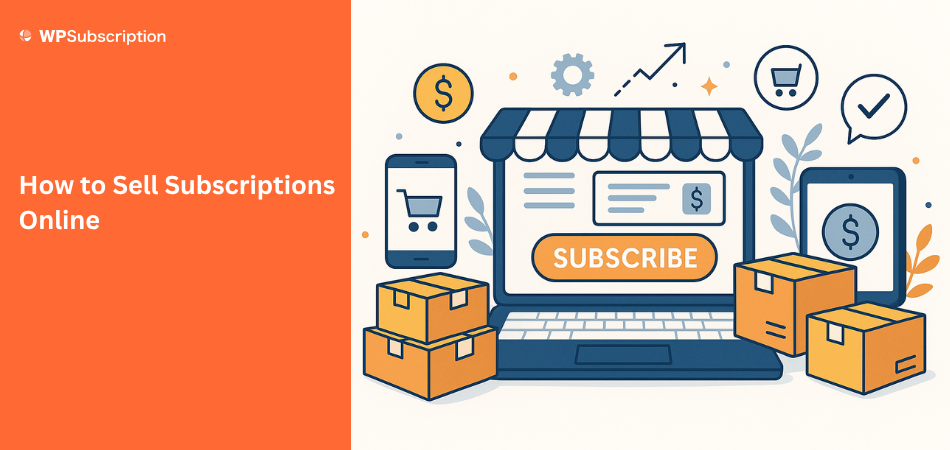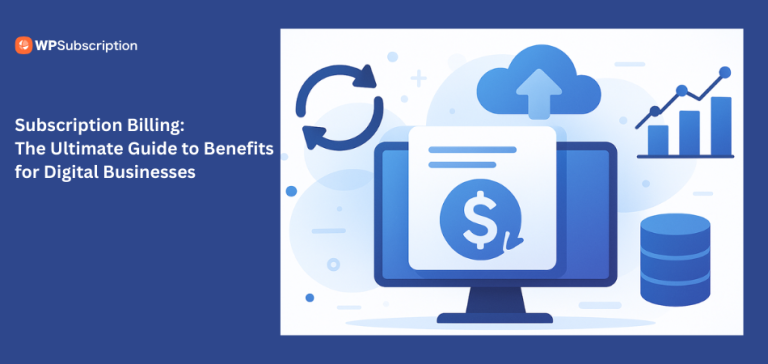Subscription businesses are growing fast. More companies are switching to subscriptions because they offer steady income and build loyal customers.
For shoppers, subscriptions bring convenience and personalized experiences. Whether you want to sell monthly boxes, digital services, or access to special content, subscriptions are a smart way to grow your business.
This guide will walk you through a complete, easy-to-follow 14-step process to start and grow your own subscription business online.
Whether you’re offering products, digital content, or services, you’ll find practical steps to take action right away.
Why Selling Subscriptions Online Is Good for Business
Running a subscription-based business online isn’t just a trend, it’s a smart, sustainable model. It gives you consistent revenue, loyal customers, and plenty of room to grow.
Key Benefits of Subscription Businesses
- Predictable Income: Regular billing ensures steady monthly cash flow, making it easier to manage finances and plan ahead.
- Lower Customer Acquisition Cost: Subscribers stay longer, allowing you to earn more per customer and spend less on constant new customer acquisition.
- Higher Customer Loyalty: The ongoing relationship builds trust, increases retention, and encourages referrals.
- Scalable Growth: Easily grow your business by offering new pricing tiers, add-ons, or bundle packages.
- Smarter Inventory Planning: With recurring orders, demand becomes more predictable, helping you plan stock, reduce waste, and improve operations.
14 Steps to Grow a Subscription Business Online
| Step | Title | What to Do | Why It Matters |
|---|---|---|---|
| 1 | Choose the Right Subscription Type | Pick Replenishment, Curation, or Access based on your product. | Aligns your model with customer needs and expectations. |
| 2 | Identify Your Niche & Audience | Define who you serve and what problem you solve. | Sharp focus makes your offer more relevant and easier to sell. |
| 3 | Study the Competition | Analyze offers, pricing, reviews, and traffic. | Helps you spot gaps and stand out with a stronger offer. |
| 4 | Validate Your Idea Early | Build a landing page, start a waitlist, or run surveys. | Ensures real demand before you build. Avoids wasted effort. |
| 5 | Outline Your Business Model | Define offer, pricing, delivery, and revenue goals. | Creates a simple roadmap for how your business works. |
| 6 | Set Up Legal & Financial Foundations | Choose a structure, open a bank account, write policies. | Keeps you compliant, protected, and organized from day one. |
| 7 | Choose an Ecommerce Platform | Use WPSubscription, Shopify, or Squarespace. | Lets you manage billing, products, and subscribers smoothly. |
| 8 | Build a Simple, User-Friendly Website | Design a clear homepage, pricing page, FAQ, and contact form. | Builds trust and drives conversions with a better user experience. |
| 9 | Create Compelling Subscription Plans | Offer flexible billing, tiers, add-ons, and incentives. | Encourages more signups and upgrades with tailored options. |
| 10 | Set Up Subscription Software | Choose tools for recurring payments, upgrades, emails, etc. | Automates your system and keeps customers engaged. |
| 11 | Promote & Drive Traffic | Use content, email, social, and influencers. | Builds awareness and brings in your first subscribers. |
| 12 | Keep Subscribers Happy | Provide support, surprise perks, and consistent value. | Boosts retention — cheaper than finding new customers. |
| 13 | Manage Finances with Care | Track cash flow, plan taxes, handle refunds, reinvest. | Ensures profitability and keeps your business healthy. |
| 14 | Scale & Improve | Add new bundles, collect feedback, expand channels, go global. | Drives long-term growth and adapts to new markets. |
Step 1: Choose the Right Subscription Type
Start by selecting a subscription model that matches your product or service. Most businesses fit into one of these three:
- Replenishment Model: Perfect for items that run out on a schedule, like coffee, vitamins, or grooming supplies. Customers appreciate not having to reorder.
- Curation Model: Focuses on delight and discovery. Think monthly book clubs, snack boxes, or fashion kits. Each shipment feels like a surprise gift.
- Access Model: Grants exclusive access to content, communities, or software. Ideal for digital products, courses, memberships, and apps.
Step 2: Identify Your Niche and Understand Your Audience
A strong subscription business starts with a focused niche and deep audience insight. The more specific your solution, the more powerful your message becomes.
- Create customer profiles: Build detailed profiles based on age, job, income, lifestyle, and values. Know their goals, routines, and what truly matters to them.
- Identify real needs: Understand their frustrations, pain points, and what’s missing from their current solutions. Use reviews, forums, and direct feedback to gain clarity.
- Explore market gaps: Find what competitors miss, outdated offers, high prices, or lack of innovation. Your product should solve a real problem in a better, fresher way.
Step 3: Study the Competition
To build a strong subscription business, you need to know who you’re competing with. Researching competitors shows what works, what doesn’t, and where you can stand out.
- Review their offers: Check what types of subscriptions they offer, how often they deliver, and what perks are included. Look for industry standards and think of ways to make your offer more unique or exciting.
- Check pricing models: Study how they price their plans. Are there basic, premium, or annual options? Do they offer free trials or discounts? This helps you spot pricing gaps you can fill.
- Read customer reviews: Customer feedback reveals pain points and what people love. Scan reviews on Trustpilot, social media, or Google to understand what you can do better.
- Use research tools: Use platforms like SimilarWeb or Ubersuggest to uncover traffic sources, top-performing content, and SEO strategies. These insights can shape your own content and marketing approach.
Step 4: Validate Your Idea Early
Before you spend time or money, make sure people are actually willing to pay for your subscription. Early validation helps you avoid building something no one wants.
- Create a landing page: Explain what your subscription offers and why it’s valuable. Focus on benefits. Add a signup form to collect interest and emails.
- Start a waitlist or pre-order: Let people join a waitlist or pre-order easily. Even a few signups can show real demand.
- Send a quick survey: Ask what problems they have, what they want, and what they’d pay. Use this to refine your idea.
Step 5: Outline Your Business Model
our business model is the foundation of your subscription business. You do not need a long complex business plan just a clear outline of how everything fits together.
- Define your offer: Describe exactly what subscribers get. Is it a box of items, premium content, or regular delivery of essentials? Be clear on value and how often they receive it.
- Choose pricing tiers: Offer monthly and yearly options. Add higher tiers with perks like exclusive content or early access to boost value and appeal to different budgets.
- Plan delivery: If it is physical, sort out packaging and shipping. For digital, set up access control or downloads. Keep it simple and reliable.
- Estimate income: Set basic goals. How many subscribers to break even? What are your target earnings? Include costs like products, marketing, and tools to see if the model is sustainable.
Step 6: Set Up Legal and Financial Foundations
To grow sustainably, treat your subscription like a real business from day one.
- Choose a legal structure: Pick the right setup for your business, such as sole proprietorship, LLC, or corporation. This affects taxes, liability, and operations. Talk to a legal or financial expert if needed.
- Open a business bank account: Keep business and personal finances separate. A dedicated account makes tracking income and expenses easier and helps during tax season.
- Register for taxes and licenses: Check local and national tax rules. You may need to collect sales tax or register for business taxes. Some products or services also require permits or licenses.
- Write key policies: Create clear privacy, refund, and cancellation policies. Add terms of service. Make them easy to find on your site to protect your business and build trust.
Step 7: Choose an Ecommerce Platform
Choose a platform that supports recurring payments, customer accounts, and easy management based on your business and tech skills.
- WooCommerce: Best for digital creators and small businesses needing flexibility and control. Customizable and cost-effective with strong subscription management.
- Shopify: Ideal for physical subscription boxes. Includes tools for inventory, shipping, and easy payment handling.
- Squarespace: Great for digital services like memberships or courses. Simple setup with beautiful design and recurring payments.
Step 8: Build a Simple, User-Friendly Website
Your website should be clean, fast, and focused on helping visitors quickly understand your offer and take action. Every section should be designed with the customer journey in mind, leading them from curiosity to confidence to conversion.
- Homepage: Clearly explain your subscription, target audience, and value. Use headlines, visuals, and a clear call to action like “Subscribe Now.”
- Pricing page: Show plans with simple descriptions and pricing options. Highlight the best-value plan.
- FAQ: Answer common questions about payments, cancellations, and delivery. Keep it easy to scan.
- About page: Share your story and mission with photos to build trust.
- Contact form: Provide a simple form and contact options for easy communication.
Step 9: Create Compelling Subscription Plans
Your subscription plans should be easy to understand, visually appealing, and structured to highlight the value customers will receive. Aim to balance affordability with enticing features that encourage higher commitment or plan upgrades.
- Choose billing cycles: Offer monthly and annual billing to suit different preferences. Clearly show the savings for annual plans to encourage longer commitments.
- Design tiered packages: Create multiple subscription levels with increasing features like priority support or exclusive content. Make it easy to compare so customers can pick the best fit.
- Include add-ons: Allow optional extras like bonus items or special event access. Add-ons help personalize the subscription and boost engagement.
- Offer first-time incentives: Attract new customers with free trials, discounts, or welcome gifts. Time-limited offers encourage people to try your service.
Step 10: Set Up Subscription Software
You’ll need a right subscription plugin to manage recurring payments, subscriber accounts, and updates.
Top options include:
- WPSubscription
- ReCharge for Shopify
- PayWhirl for general ecommerce
Look for features like failed payment recovery, flexible upgrades, email reminders, and in-depth analytics.
Step 11: Promote Your Subscription and Drive Traffic
Now that your subscription is ready, it’s time to share it with the world. Marketing is how you attract your first subscribers, build momentum, and expand your reach.
- Choose billing cycles: Offer monthly and annual plans with clear savings for yearly commitments.
- Design tiered packages: Create levels with extra features and easy comparisons.
- Include add-ons: Let customers add bonuses or special access.
- Offer first-time incentives: Use trials, discounts, or gifts to encourage sign-ups.
Step 12: Keep Your Subscribers Happy
Acquiring customers is only half the journey. Retaining them is where sustainable growth happens. Focus on delivering a consistently great experience and building long-term relationships with your subscribers.
- Provide fast and friendly support: Make it easy for subscribers to get help when they need it. Respond promptly to questions, technical issues, and cancellation requests.
- Deliver consistent value: Stay true to your promises and continue enhancing your offering. Whether it’s physical products, digital access, or curated content, make sure every delivery meets or exceeds expectations.
- Surprise and delight: Small, unexpected touches can go a long way. Send personalized thank-you messages, surprise gifts, or exclusive content to show appreciation.
Step 13: Manage Your Finances with Care
Recurring revenue can create financial stability, but it still requires disciplined management. Keep a close eye on your cash flow, set up systems, and prepare for the long term.
- Track all income and expenses: Use accounting software such as QuickBooks, Wave, or Xero to monitor your financial health.
- Plan for taxes: Set aside a portion of your earnings every month to cover tax obligations. Consult a tax professional if needed to stay compliant and avoid unexpected bills.
- Handle refunds and chargebacks: Create clear refund policies and display them transparently on your website. When issues arise, respond quickly and professionally to resolve them.
- Invest in your business: Reinvest part of your profits into areas that improve the customer experience. This could include upgrading your website, adding new features, improving packaging, or hiring support staff.
Step 14: Scale Your Business and Keep Improving
Once your subscription is stable, look for opportunities to scale. Growth comes from listening to your customers, testing new ideas, and staying adaptable as your market evolves.
- Launch new plans or bundles: Expand your offering with creative options. Consider seasonal packages, corporate subscriptions, limited-edition bundles, or gifting plans.
- Collect and act on feedback: Ask subscribers what they think through surveys, polls, or direct conversations. Use their input to improve your product, add features, or adjust pricing.
- Test marketing channels: Explore new ways to reach potential customers. Run small-scale campaigns across platforms like Google Ads, Facebook, Instagram, or TikTok.
- Go global: If your product allows it, consider expanding internationally. Support multiple currencies, offer international shipping, and provide translations if needed.
Final Thoughts
Starting a subscription business in 2025 is a smart and sustainable path for creators, solopreneurs, and small teams. Customers love the ongoing value, and you benefit from reliable revenue and deeper relationships.
With the right niche, strategy, and tools like WPSubscription, you can build a business that works for you month after month.
Follow this step-by-step plan, stay focused, and remember: every successful subscription brand started with one idea and the courage to launch.




